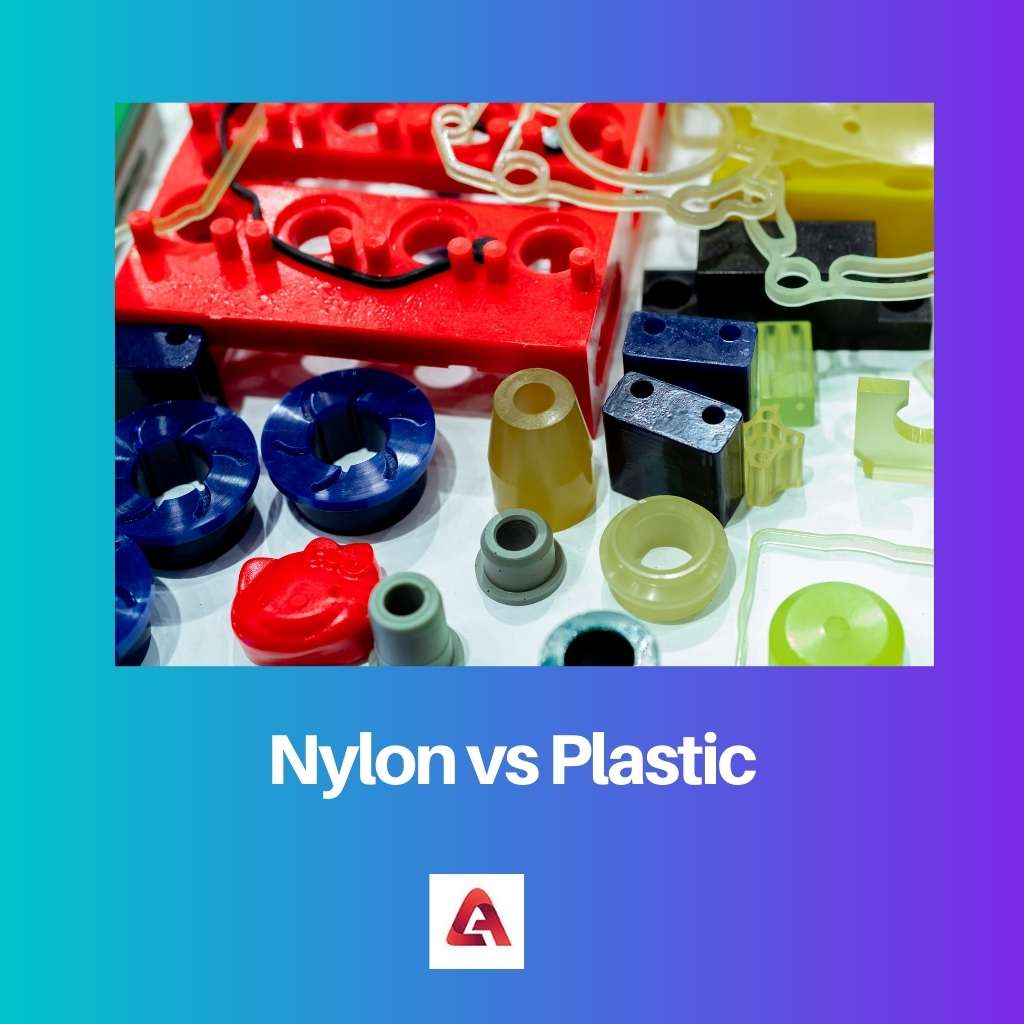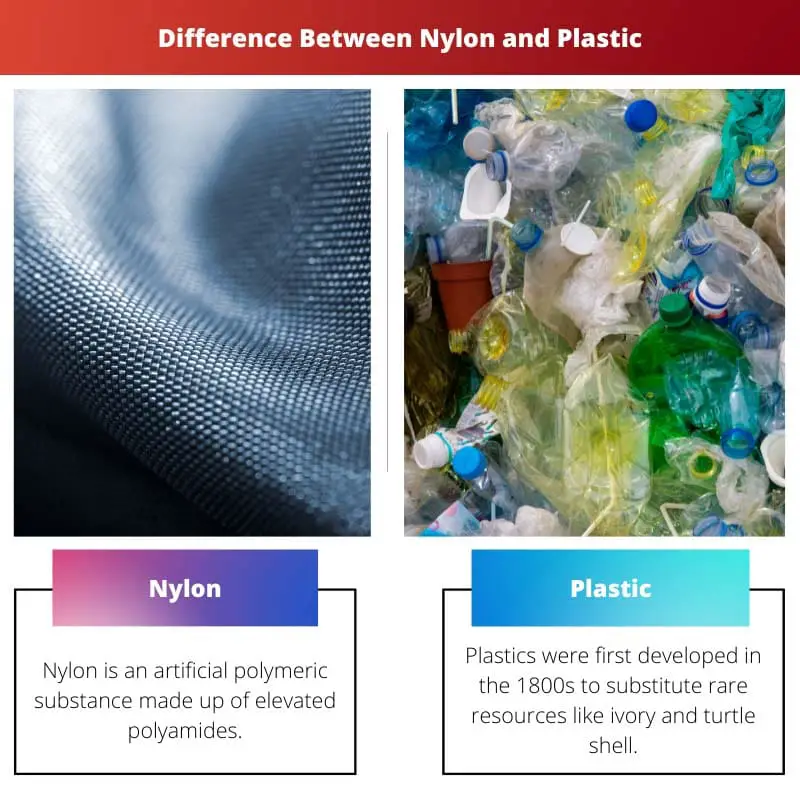Humans are capable of doing so many things they are the supreme creature on this planet, with the ability to think and make their thought a reality is the quality of human beings.
Humans have changed since time immemorable and along with us, the things around us have also changed, humans have created so many things for their comfort and luxury.
This article talks about the basic creation of human beings i.e. Nylon and Plastic; it is daily life material that has served many purposes. What is the difference between the two and what purpose do they serve? Let’s find out.
Key Takeaways
- Nylon is a synthetic polymer called a polyamide, known for its strength, elasticity, and resistance to wear.
- Plastic is a broad category of synthetic or semi-synthetic materials made from polymers with diverse properties and applications.
- Nylon is more durable and flexible than most plastics, making it ideal for applications like textiles, ropes, and gears.
Nylon vs Plastic
Nylon is a man-made polyamide material created from petroleum byproducts, while plastic is a type of polymer that can be made from petroleum or other sources. Nylon tends to be stronger and more expensive than most types of plastic due to its molecular structure. Thus it needs extra processing.

On February 28, 1935, W. H. Carothers of DuPont’s experimental laboratory created the initial sample of Nylon (nylon 6,6) utilizing diamines.
On January 29, 1938, Paul Schlack of IG Farben produced nylon 6, a new chemical dependent on caprolactam (a synthetic crystalline compound).
In 1938 Nylon was widely utilized as a nylon-bristled toothbrush, afterwards, it was more popularly used in women’s stockings. It first became economical in the year 1940.
The most prevalent Plastic is polyethylene, sometimes known as polythene. The worldwide manufacturing is estimated to be over 80 million tonnes per year.
Its main application is in packing (plastic raincoats, plastic sheets, boxes, etc.). Plastic comes in a variety of forms, the majority of which have the molecular formula (C2H4)n.
Plastic is made up of a combination of ethylene polymers having comparable n values.
Comparison Table
| Parameters of Comparison | Nylon | Plastic |
|---|---|---|
| Durable | More Durable | Less Durable |
| Heat resistance | More resistance to heat | Less resistance to heat |
| Melting Point | 268.8 °C | 160°C – 210°C |
| Compound used | Adipic acid and Hexamethylenediamine | Carbon, hydrogen, oxygen, nitrogen, sulfur, and chlorine. |
| Time taken to decompose | Approximately 30 – 40 years | 20 to 500 years |
What is Nylon?
Nylon is an artificial polymeric substance made up of elevated polyamides that are frequently, but not necessarily, formed as a fiber. It was created in the 1930s by a research group led by Wallace H. Carothers.
The tensile power of Nylon is 12,400 psi (pounds per square inch).
It’s utilized in a variety of applications, including cord, to strengthen rubber materials (such as automobile tires) or garments, and even to replace low-strength elements.
Using a spinneret, Nylon can be pulled, molded, or extruded from a melt or fluid to produce fibers, threads, brushes, or films that can be spun into yarn, cloth, or braided rope; it can also be shaped.
Apart from these, there are various other beneficial features of Nylon such as:
– In comparison to Plastic, Nylon is the hardest substance.
– Nylon is extremely resilient, making it ideal for use in irrigation systems, cattle, and farms.
– Nylon can withstand the most bending and straining.
Although Nylon is a useful material in our everyday life, it also has some disadvantages such as;
1) Since Nylon is resistant to fire, it dissolves quickly.
2) Whenever Nylon is moist, it expands and degrades quickly.
3) Nylon has little UV tolerance and turns yellowish no matter what color it is, making it frail and quickly decaying.

What is Plastic?
Plastics were first developed in the 1800s to substitute rare resources like ivory and turtle shell. Cellulose, a material present in trees and shrubs, was used to create the first synthetic polymers.
Cellulose was burned with chemicals to create a new, incredibly durable substance.
The basic components for today’s modern plastics originate from a variety of sources (some even use salt ), but the majority of them may be manufactured using hydrocarbons found in organic gas, petroleum, and charcoal.
Plastic is a long-lasting polymer with various crystalline compositions, it is produced in millions of tones per year all around the globe.
It has a wide range of applications, including laminates, plastic components, pipes, shields, etc. Plastic is a polymeric substance with the capability to be molded or formed, with the use of fire and compression.
The feature of plasticity allows Plastics to be frequently combined with various specific features like low weight, electrical resistivity, opacity, and hardness, enables plastics to be produced into a wide range of items.
Plastics are very versatile and are used to make various substances it has become the need of every household, some of the benefits of Plastics are listed below:
-Plastic is long-lasting and water-resistant in contrast to other polymeric substances; it will last long even if exposed to extreme climate.
-Plastic has several qualities that make it suitable for a wide range of purposes.
– It has excellent durability and is quite bendable despite its low strength and hardness; rather than shattering, it will expand.
Plastic has played a major role in comforting the life of the people, however, there are some negative impacts of Plastics as well, that includes:
– Plastic has poor UV and thermal tolerance.
-The compounds used in Plastic manufacture are poisonous and harmful to human health.
– As Plastic decomposition takes a long time, the waste produced causes a threat to humans, animals, and sea creatures.

Main Differences Between Nylon and Plastic
1. Nylon is stronger than Plastic.
2. Nylon was invented by Wallace H. Carothers whereas Plastic was invented by Leo Baekeland
3. Nylon was first commercially sold in 1940 and Plastic was commercially sold in 1862.
4. Each year 8 billion pounds of Nylon are produced worldwide, whereas 80 million tonnes of Plastic are produced all over the world.
5. Nylons are used to make fabric, industrial machine parts, threads, tents, etc. Whereas Plastics are used to make bottles, bags, sheets, etc.




